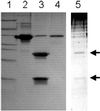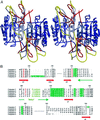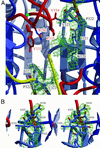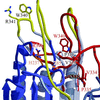Structural basis for the activation of human procaspase-7
- PMID: 11752425
- PMCID: PMC64937
- DOI: 10.1073/pnas.221580098
Structural basis for the activation of human procaspase-7
Abstract
Caspases form a family of proteinases required for the initiation and execution phases of apoptosis. Distinct proapoptotic stimuli lead to activation of the initiator caspases-8 and -9, which in turn activate the common executioner caspases-3 and -7 by proteolytic cleavage. Whereas crystal structures of several active caspases have been reported, no three-dimensional structure of an uncleaved caspase zymogen is available so far. We have determined the 2.9-A crystal structure of recombinant human C285A procaspase-7 and have elucidated the activation mechanism of caspases. The overall fold of the homodimeric procaspase-7 resembles that of the active tetrameric caspase-7. Each monomer is organized in two structured subdomains connected by partially flexible linkers, which asymmetrically occupy and block the central cavity, a typical feature of active caspases. This blockage is incompatible with a functional substrate binding site/active site. After proteolytic cleavage within the flexible linkers, the newly formed chain termini leave the cavity and fold outward to form stable structures. These conformational changes are associated with the formation of an intact active-site cleft. Therefore, this mechanism represents a formerly unknown type of proteinase zymogen activation.
Figures





References
-
- Barrett A J, Rawlings N D. Biol Chem. 2001;382:727–733. - PubMed
-
- Salvesen G S, Dixit V M. Cell. 1997;91:443–446. - PubMed
-
- Thornberry N A, Lazebnik Y. Science. 1998;281:1312–1316. - PubMed
-
- Nicholson D W. Cell Death Differ. 1999;6:1028–1042. - PubMed
-
- Stennicke H R, Salvesen G S. Biochim Biophys Acta. 2000;1477:299–306. - PubMed
Publication types
MeSH terms
Substances
Associated data
- Actions
Grants and funding
LinkOut - more resources
Full Text Sources
Molecular Biology Databases

